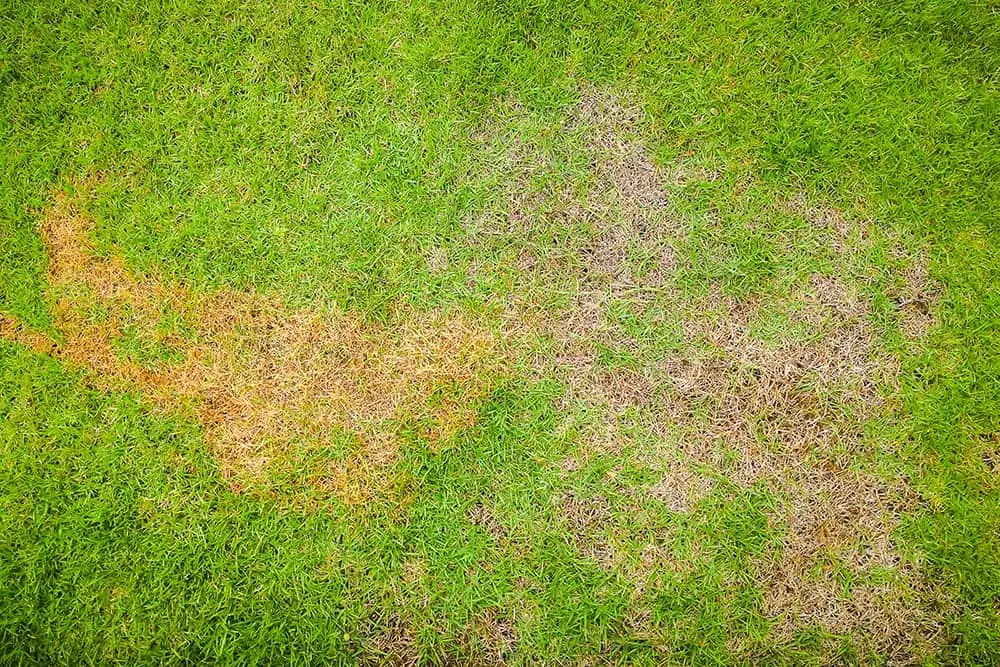Lawn disease will not typically cause any major threats to your lawn, but these diseases can often occur after a long period of heat and humidity, and they can also be caused by other things.
Something that everyone should know is how to spot diseased grass to stop it becoming a big problem.

For the most part, your grass is likely to remain free from disease and fungus as long as you carry out proper maintenance, but it can happen sometimes. Knowing the signs of what to look out for can help you to catch these things early and solve the issue.
In this article, we are going to tell you how to identify if your grass has become diseased, and some of the things that you should make an effort to look out for. This will make it much easier for you to tell if you have a problem in your yard.
Table of Contents
What Does Diseased Grass Look Like?
Diseased grass can look like anything from brown patches of dead grass to clear mold and mildew in the ground. One of the most common types of diseased grass in the brown patch, which can often occur in circular patches in the lawn.
These patches will likely be a brown/yellow color, and they can range from anywhere between six inches and multiple feet in diameter.
This type of lawn disease can affect all cool-season lawn grasses, but it can cause the most damage to ryegrass and tall fescue. There are other types of grass that can also be affected on occasion, but the damage is not likely to be as bad as the ones that we have mentioned.
Brown patch can also affect a variety of warm-season grasses, like St. Augustine grass and Zoysiagrass.
Something that can be helpful to know is that brow patch is most likely to occur during or after extended periods of heat and humidity, more commonly, when night temperatures stay higher than 68 degrees Fahrenheit.
What Does Fungus in Grass Look Like?
Fungus in grass can look like many different things, as there are lots of different types of fungus that could be causing the problem. Different types of fungus will present themselves differently, but we will explain what some of the types of fungus look like below.
Powdery Mildew
Powdery mildew, as you might have guessed, is a common fungal disease for many plants to develop.
Plants can become infected with different species of this disease, and when it comes to lawns, it is most commonly found on cool-season grassed. One of the most common types of grass to find this fungus on is Kentucky Bluegrass.
Powdery mildew can develop very quickly on your lawn, and it can commonly appear in shady areas, especially when it has been quite overcast outside. This type of fungus looks like a white dust, and it isn’t very pleasant.
Red Thread
Another type of fungus that you may have to deal with at some point is red thread, and we probably don’t need to tell you what color this is.
If this is the type of fungus that you are dealing with, you will notice that there is red or pink webbing or thread on your grass. Red thread will usually appear when there are particularly low levels of nitrogen in the soil.
The good news is that red thread is mostly harmless, and it can actually be used as an indicator to tell you that you need to fertilize your lawn.
Some of the grass types that suffer with this fungus the most are cool-season grasses like red fescue, rye grass, Kentucky bluegrass, and bentgrass.
This is actually one of the most common types of fungus to grow on your lawn, and it can lead to patches of dead grass on your lawn during wet summers and autumns.
The fungus that causes this issue is called Laetisaria fuciformis, and it will rarely ever kill off all of the grass completely. Thankfully, any patches that have been affected by this fungus will be able to recover well if action is taken.
Snow Mold
Another type of fungal disease that you might have heard of is snow mold, which will usually appear in the early spring time as the snow begins to melt. There are actually two different types of snow mold.
These are gray snow mold, which is also known as Typhula blight, and pink snow mold, which is also known as Fusarium patch.
The pink snow mold will infect the crown of the plant and is often known to be more damaging than gray snow mold. Gray snow mold will only infect the leaf tissue.
In general, snow mold will be caused after there has been snow covering the ground that is not completely frozen. It can also appear in long grasses that have not been mowed before winter arrived.
Fairy Ring
The last type of grass fungus that we are going to talk about is fairy rings, which are naturally occurring arcs of mushrooms in grassed areas or forests.
They can be found in the form of either a completed or partially complete circle, and they can grow up to 30 feet in diameter.
So, if you spot this type of fungus growing, you will need to put a stop to it sooner rather than later. Though, they are really hard to get rid of. There are three types of fairy rings that are found on lawns, which are:
- Those with a darker green flush of growth along with a zone of dying grass and mushrooms
- Those with only a darkened green ring and mushrooms
- Those with only mushrooms.
How to Treat and Prevent Lawn Diseases
Now that you know how to spot a lawn disease, you might be wondering how you can treat it or stop it from occurring again once you are rid of it. We will leave you with some tips below:
- Make sure that the pH levels of the soil are correct
- Always properly fertilize your lawn when needed
- Mow the lawn regularly

